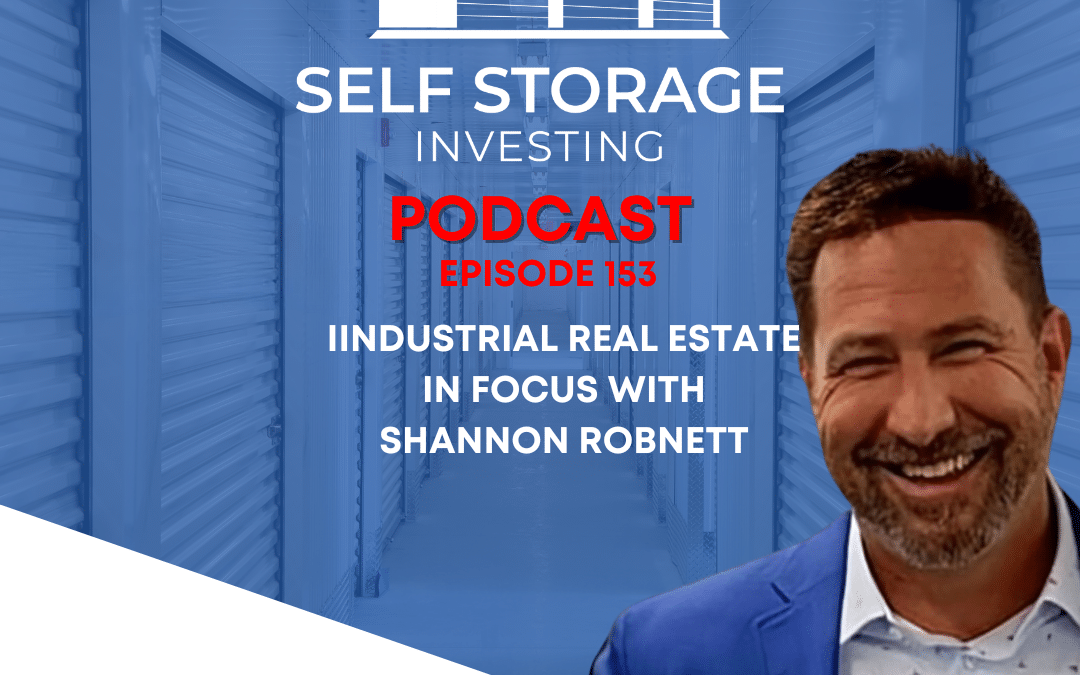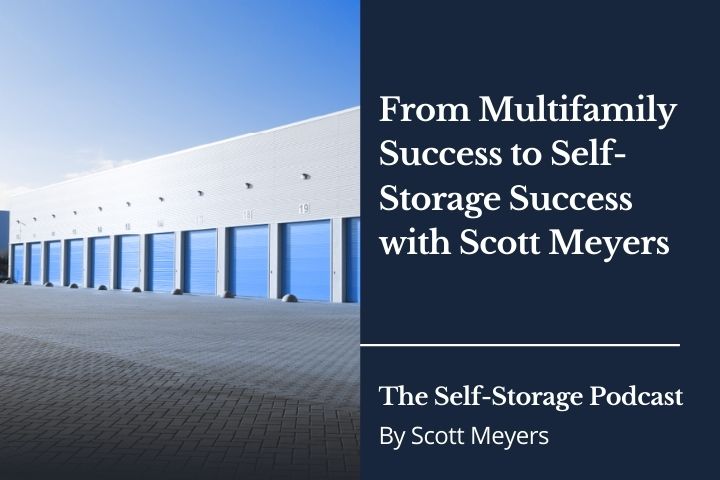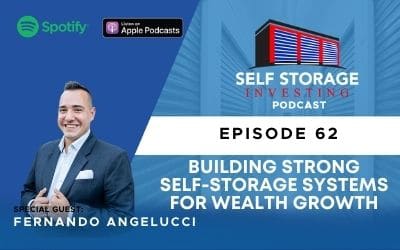Shannon Robnett is a real estate investor with a focus on multifamily and industrial properties. In this episode he shares his journey into real estate, starting from a family background in the industry to his current success in syndicating capital. He discusses the importance of understanding market cycles and the fundamentals of real estate investing.
Robnett also highlights the potential of industrial real estate, particularly in the context of reshoring and the need for flexible industrial spaces. He emphasizes the importance of prudence and ensuring that a property can stand on its own, rather than relying on future projections.
WHAT TO LISTEN FOR
2:09 Why Growing Up in a Real Estate Family Was Important for Shannon
3:17 Shannon’s transformation from Residential to Commercial
4:07 The Evolution of Investment Strategies and Capital Raising
23:26 Market Analysis and Asset Class Evaluation
Leave a positive rating for this podcast with one click
ABOUT SHANNON ROBNETT
With 27 years experience, Shannon is a prominent real estate developer and syndicator in Boise, Idaho. The family legacy runs deeper – spanning five generations of real estate professionals to provide an expertise ingrained in the family’s heritage. The specialization revolves around procuring developmental land and navigating its entitlement. Once the stage is set for construction, the involvement of syndication partners comes into play.
CONNECT WITH SHANNON
https://shannonrobnett.com/contact-us/
CONNECT WITH US
Website | You Tube | Facebook | X | LinkedIn | Instagram
Follow so you never miss a NEW episode! Leave us an honest rating and review on Apple or Spotify.
Sign up for the December 28, 2023 Masterclass
Episode Transcript
Shannon Robnett (00:00):
Yeah, and Scott, in my defense, I’ve done almost everything backwards, so it was nothing new to do it this way.
Announcer (00:17):
This is the Self Storage Podcast where we share the knowledge and skills from the industry’s leading investors, developers, and operators to help you launch and grow your Self storage business. Your host, Scott Meyers, over the past 18 years has acquired, developed, converted and syndicated nearly 5 million square feet of Self storage nationwide with the help of his incredible team at Selfstorageinvesting.com, who has helped thousands of people achieve greatness in Self storage.
Scott Meyers (00:52):
Hello everyone, and welcome back to the Self Storage Podcast. I am your host Scott Meyers, and we have a very special guest today, Mr. Shannon Robnett. Shannon and I share the same philosophy in investing and our trajectory has been roughly the same. We’ve been investing in real estate about the same amount of time we’ve taken pivots along the way. We raise capital, we coach, we teach people. So very, very similar in terms of how we approach investing in real estate. Although Shannon is very heavy into multifamily. His background is in industrial. And as we’ve chatted before in the past on the Self Storage Podcast about what we’re seeing in the industrial markets, I thought it was great to have Shannon to come on and talk a little bit about that from what he’s seen in his vast experience and knowledge in the industry for a number of years, but also how he is looking at that side of, but also as to how he is approaching that asset class as we head into this next economic cycle. So with that, Shannon, welcome to the show.
Shannon Robnett (01:52):
Hey, thank you Scott. Appreciate you having me on.
Scott Meyers (01:55):
Well, glad to have you here, Shannon. And if you would, I don’t want to steal any of your thunder and I can’t give your bio and your background as well as you can. So tell us a little bit about how you got invested or how you got involved in real estate, what you’re investing in and where you find yourselves right now.
Shannon Robnett (02:09):
Well, I was actually born into a real estate family, and so I grew up with a mother who was a real estate broker, third generation. I’ve had my license, my son still has his and a father who was a developer and a builder. And I actually grew up at Port dad’s table. So I would constantly hear my parents talking about 10 31 exchanges and how we can get some cashflow and how we can sell this property and build this property. And I really took that for granted until I’d attempted the college route. I decided that definitely wasn’t for me. They wanted me to show up every week. They wanted me to do these homework assignments. Meanwhile, my brother had followed my father into home building and was making 45, 40 $7,000 a year back in 1994 right out of high school. And I thought, man, this is really stupid to pursue a degree in computer information systems where I get to go to work for somebody else and get told what to do, which I wasn’t even liking being told to show up at college.
(03:17):
And so I went that route. I went to my dad, I said, I want to build some houses. And he said, okay, go get the backhoe. And really showed me how to do every aspect of the trade that I had done. And it was very interesting, Scott, because at this time I was doing it, but I was getting paid for it where I’d done it in the past for my father, and it was just free labor, but I really quickly learned I didn’t like homeowners. And so I pivoted into industrial and commercial. I did city halls, fire stations, police stations, hospital type facilities, medical gymnasium schools, all that kind of stuff. And I really saw how when I got done with that process, after building three and a half, $400 million worth of work, I saw how when I was done with that, I stopped getting paid, but the people that owned the property did.
(04:07):
And in 2001 the same year that my mother and my father were retiring at the rip old age of 50 with cashflow, I put together my first industrial project. And to this day, Scott, two of the original tenants are still in the building 23 years later, 22 years later. And they do very simple things, whether it’s make gelato ice cream, batting cages, window tinting, cabinet shops, manufacturing facilities, they continue to pay the rent because they need a place to do business. And I did that for quite a while. I would put away an asset or two every couple of years for myself, and I just saw how my projects began to get bigger. So I went out and I began to approach single check writers to do projects with to partner with, and I very quickly ran out of capital there. The last project that I did with just one partner was a family office, and they wrote a check for $19 million.
(05:05):
And I realized that I was not going to be able to sustain this where I was constantly finding one person or one group that liked my idea enough. And in 19 2019, at the end of the year, I began to syndicate capital. And I’m be a little bit honest here, Scott, the first deal I did, I raised $1.8 million and it took me almost five months to raise it. And it wasn’t because it wasn’t a great deal. I mean, we returned 39% to our investors on that particular deal, but it was because I was doing something new that I hadn’t really done prior and I wasn’t approaching it the right way. And as I began to look at my resume, my resume was full of great opportunities and fantastic things, but I wasn’t resonating with investors on how they could participate in this. And as I began to change my approach over the last four years, three and a half years, we’ve raised about 62, 60 $3 million in capital.
(06:03):
We’re getting ready to go into this next year looking for about 28 million in the first two quarters for projects we have on the books. But I’ve really seen how in that educating people about the opportunities that are available to them in a passive role has changed really my perspective on whether or not I’m a teacher or whether or not I’m a mentor because I never really saw myself that way. But when I realized that people are so hungry for that knowledge and that information on how can I do this, how can I be successful? How can I get my money out of Wall Street? How can I own real assets? How can I have tax benefits? It really has changed, well, not very strongly, changed my thought process on how much normal Americans want that information and need that information to make financial decisions that really truly set them up for retirement for a passive income that will truly support them.
Scott Meyers (07:09):
Well, that’s interesting, Shannon, because many folks, as you know, and as you continue to show people how to invest our limited partners or those folks that are investing passively when we’re raising capital and syndicating it, we usually start in that realm, what we call the retail arena where people are investing 50 to a hundred thousand and then we graduate to the single check regular. It’s like a family office that is writing a check for 19 million. But you seem to do it backwards either way. There’s a learning curve involved in it though, correct?
Shannon Robnett (07:38):
Well, yeah, and Scott, in my defense, I’ve done almost everything backwards. So it was nothing new to do it this way, but in going to people that knew my reputation and were in my local vicinity, it was actually quite easy to do that. But then when I started branching out beyond that, we’ve got projects in Washington all the way down to Florida. When you branch out beyond that, you can’t take all your investors with you and then you find that most don’t give you their first or their last 50,000 or a hundred thousand dollars, but you wind up in situations where maybe, and this is another thing that we learned very quickly, maybe this isn’t the right deal for them. Maybe they need something that they’re looking for an appreciation play, they’re looking for a tax play. Maybe they’re looking for just long-term cashflow and in a ground up development deal, they may not be able to find that like they want.
(08:39):
And so we’ve really looked at educating investors on what they want, right, taking the why of what they’re doing. If they’re in their mid forties and they’re a doctor or a dentist or a high paid it worker, a tech worker, they’re making a lot of money and the money’s not what they’re looking for right now. They’re looking for tax breaks and then making them aware of the tax breaks that are available and then offering something that does fit that need maybe more heavily on the tax breaks than on the cashflow portion of it where they can really see their money appreciate just through the fact that they’re not paying Uncle Sam 35% of their income.
Scott Meyers (09:20):
Well, since 2019 when you started syndicating on that end, it has been a matter of we’ve seen really good gains in real estate, in our investments, in our syndications and in our funds. It is a matter of doing just what you had mentioned, having the three, for lack of a better word, three buckets of investors that invest with us somewhat cashflow, someone appreciation, and some are really looking for depreciation. And so then we try to funnel them into our investments that best fit their needs. And as you said, by educating them, now we turn the corner as of this year and partly ended 2022, where the market cools a little bit and the education is not so much as to what investment to invest in given those needs, but that you really should get off the sidelines and begin investing. For those that have kind of pulled back and are listening to the narrative, which is mostly negative and why they should be sitting on the sidelines. So how have you approached your investors and the market from that standpoint, getting them to engage again in your projects?
Shannon Robnett (10:18):
Well, from the market standpoint, Scott, you and I have been doing this long enough that when we saw interest rates do what they did, we were ecstatic just like everybody else, but we knew not to count on it. We know that there’s cycles in real estate and we know that what is here today can be of benefit regardless of what that market is. And we’ve always stuck with the fundamentals. We’ve got a project that we’re getting ready to exit first quarter of next year, and I look back at the underwriting and I was looking at a brand new multifamily project at a 5, 7, 5 cap rate and 7% financing. That was my assumption going in. It’s worked. My investors are going to be well rewarded even though exit right now. Some people may go, well, why are you doing that? Well, because that was the business plan and based on the plan and the underwriting that made sense, we were able to get great returns.
(11:16):
But it comes back to that, Scott, you and I have been doing this for 30 years, and we know that those cycles in the markets, there’s great places to take advantage of any cycle in the market based on an understanding of where you’re at in the position of the market and what your investors can expect. And I truly do believe that there are great deals out there right now to do if you’re understanding of the market, if you’re running on 2020 ones data that, hey, we can’t do anything because we don’t have 3% interest rates and we’re looking to buy something at a three cap and sell it at a two and a half cap. Some of the other things that you and I have both seen in underwriting models, sure you should sit on the sidelines, but there’s those that have the ability to look at it. And while cap rates have changed and interest rates have changed, the fundamentals, the true fundamentals of what makes money in real estate are still very, very true and extremely accurate in any market.
Scott Meyers (12:13):
And that’s what we tell our investors and that’s what we tell our students is that my underwriting model, and I don’t want to break it down to say it’s just an Excel spreadsheet, the model doesn’t change, but it really doesn’t. What changes is the inputs, my cost of capital changes and my projected exits in terms of our cap rate. That’s what changes. And we do our best given the economists that we follow and the trends. And again, yeah, leaning on the three recessions that we’ve been through, call it four, including the pandemic to be able to as best as we can accurately project where we’re going to be. And as long as you stay disciplined with that approach, then no, you nor your investors, should be surprised on the backend. And I think many times investors when it’s their first cycle, they get a little bit tripped up and they don’t understand exactly what that looks like or fear just keeps ’em from making any of those projections because they don’t want to make a mistake and end up unhappy or with unhappy investors on the backend and they too find themselves the active investors sitting on the sidelines as well.
(13:12):
Would you say that’s accurate and are you seeing the same?
Shannon Robnett (13:14):
Absolutely. And Scott, there’s two things in real estate that you really need to be looking at. One is experience, right? You want to work with experienced teams that have been through these things. They’ve got knots on their head, they’ve got bumps, they’ve got bruises, they’ve got war stories. And the other thing that real estate provides you is time. Time can turn things around from the bottoms of oh eight, I mean oh nine, man, we look at it now, what a great time to have bought things, but at the time you couldn’t give houses away. You couldn’t give properties away. And so it’s understanding what is the next step in the cycle. And when people can truly understand that and they can embrace that, they’ve got the knowledge, they’ve got the experience, and they’ve built in, let’s see, plan DE, F, G, H and I, they’re going to get through it because there’s time and there’s runway and there’s longevity to the ownership of real estate that you may not find and probably won’t find in other asset classes like stocks and things like that.
Scott Meyers (14:20):
Yeah, we looked around the landscape in 2009 and I watched my friendly competitors and my compatriots in self-storage, the REITs, the big guys, the folks that had deep pockets and good lending relationships, they clean house. And then I watched them all sell massive portfolios and massive amounts of real estate back in 2020. And we recognized in 2009 we participated in that as well, and we bought as much as we could with what we had. And I vowed, I said at this point, every seven to 10 years, like we run into a recession and I will not get caught in this position again. And so that’s where we began to create the war chest that we have to be able to invest and increase our Rolodex and we’re in that situation right now. And to your point, I guess one thing I’d like to add before we move on is folks, for anybody out there that’s looking to invest with Shannon or myself or anybody for that matter, and do it as an lp, a limited partner in a passive fashion, Shannon, you hit the nail on the head and I heard somebody, a head of a family office say, you should never invest with, you should never go into war following a general who doesn’t have a limp.
(15:26):
So the investors that have a little bit of scarred tissue and have a little bit of experience, those are the folks that you want to follow. And for all the folks out there that have said, well, I’ve never lost a dime of investors’ money, but I’ve only done one syndication, those aren’t the folks that you should be investing with. But if you will, I’d like to change gears. That brings us to where we are today. There is, as you and I were talking off camera, there’s a lot of movement that we’re seeing right now in the industrial space. We’re seeing a massive reshoring, I think I saw recently, 48% year over year, 48% of manufacturers companies that have moved overseas are coming back into the us. It’s driven by many things. China has a population issue, they have an energy issue. Europe has a massive energy issue, and we’ve got quality issues for many companies that have tried to go overseas in different countries to do it inexpensively. And for all those reasons combined, we’re seeing the border states, we’re seeing many other states, manufacturing is coming back to the US and is coming back in large waves and tranches, you’re in this space, tell me what you’re seeing.
Shannon Robnett (16:35):
We are seeing exactly that. And the other thing that you can also look at is when economies are threatened, when we see layoffs, when we see things like that, it’s also correlates directly to the number one time in US history where small businesses are created. A lot of people forget that 60% of business that’s done in America is done by small businesses. And so when you look at that, you’ve got a guy that just got laid off from a tech job, he’s got his life’s dream of always opening a t-shirt shop or whatever like that. And we see those people taking that leap of faith because they realize that they have served their JOB and it hasn’t served them. And we’re dealing with an international company on a project right now where they’re continuing to build in the United States because they see that it is one of the places that they can have certain, I want to say inalienable rights, but they have certain things that happen in government or in business consistently that they’re seeing doesn’t happen all over the world.
(17:40):
And so the other thing that I look at with environments like this is industrial is predominantly triple net. And in that triple net product, that means that the rent is the rent and the expenses are an additional estimate that is charged to the tenant. And so while we’re seeing insurance costs skyrocket and while we’re seeing property taxes continue to climb based on values from a couple of years ago, we’re seeing that this is something that most small businesses can’t absorb because really typically only 10% of their rent or 10% of their gross income goes to their rent. And so if they have a 10% increase in their rental costs because of additional expenses, it doesn’t put ’em out of business where the multifamily space is really struggling with that because the people that are typically inhabitants of apartments, they’re getting hammered with the cost of fuel and the cost of chicken and rising costs in their everyday life that don’t allow them to just willy-nilly increase the rent by 10% because it’s already 35 to 40% of their income as it sits.
Scott Meyers (18:51):
Good point. Very good point. And also another reason why, once again, if you look at the asset classes that have done very well, industrial has weathered the storm in terms of inflation and recession and has been a constant. It’s also backed by, for the most part, as you mentioned, triple net leases and companies that have really good guaranteed rents. And so many of the investors in industrial like yourself haven’t been affected that much.
Shannon Robnett (19:16):
Another thing that we’re seeing with that is, like you said, in 2009 and 10, a lot of the REITs and everything are involved in the mini storage space, which is true. I built a couple. And the reality is they’re also heavily involved in industrial. Another interesting thing about industrial is life insurance companies love to do lending on them because they can fix the rate typically much more stable in upsetting economic cycles. And so getting those things to happen and getting long-term debt that is favorable is always easier. And I kind of think of industrial is kind of like the bond of real estate. You’re not going to see the spectacular returns that you might see in other asset classes. Although we have seen returns of up to 104% on some of our industrial assets over the last couple of years thanks to the market, not my genius, but we also see that they’re very steady, they’re very stable and they don’t tend to have a lot of upsetting things that happen to them. So when you’re looking at that, it’s definitely something that is very strong for cashflow. It’s very strong for a consistent appreciation. And cap rates don’t tend to fluctuate as much on them as they do some other asset classes.
Scott Meyers (20:41):
A lot of what we’re looking at in terms of where we’re at self storage falls into the industrial space, although it is its own asset class as well. But what we’re looking into now is with the reshoring and the race to win in the last mile space, what does that look like? Not a 10 by 10 or a 20 by 20 cell storage facility, but it’s also not a 20,000 square foot space in an industrial building. It’s somewhere in between for those distributors, even these small distributors, to be able to get stuff out to the last mile. Are you seeing that? Are you planning for that? Are you accommodating that in your plans going forward? How are you approaching that opportunity if you think there is one?
Shannon Robnett (21:25):
Yeah, I definitely see that opportunity. And one of the things that I love is the flex industrial space, right? It’s the smaller space that is exactly what you talked about. It’s somewhere between two and 10,000 square feet. It has two common needs. It needs to be lockable. So there’s a roll-up door up the front, and there’s a bathroom in the back. Most of the time they don’t even care for the office except somewhere to store their lunch and they’re wanting these spaces and they’re growing. So they’ll take 2000 square feet, then they’ll call and they’ll say, Hey, I need 4,000, I need 6,000. But it’s really an incubator space that is allowing people to position and be fairly nimble in how much space they’re taking because then they look at it and they say, okay, in that last mile race, we need to be in this proximity and we could pay more rent because we’re dealing with a high pile situation, we’re dealing with a smaller space, but we’re also, we’re close to where we need to be. We’ve seen a huge surge in that demand, and it’s definitely something that we’ve bought assets in that genre, if you will, in the last year that have proved to be very, very good investments for us, including rent increases of up to 12% in the last four or five months.
Scott Meyers (22:45):
So Shannon, in your, I’m going to ask you to pull out your crystal ball here, unless it’s in the shop or
Shannon Robnett (22:52):
I just got a new One,
Scott Meyers (22:53):
it’s broken. You got a new one? Yeah, that good timing. I’m glad. Hopefully we grabbed you from the first podcast then. You heard it here first, folks, you’re in multiple asset classes and each is affected a little bit differently by rising interest rates, cap rates, and what’s going on in the economy, maybe run through the three or four that you’re involved in or what’s your overall take on which asset classes are going to come out, the winners as we head into this next cycle, whether we hit the bottom and then come back out? Who’s poised to win in this race right now?
Shannon Robnett (23:26):
Well, Scott, I think in order to understand an asset class, you need to look at the market it’s in. And we’ve identified nine markets across the nation that we see not only rising residency, but people moving in. But we also see rising wages. There’s certain areas that aren’t seeing the rising wage, but if you don’t have wages going up, it’s really hard to raise rents if wages are static. And so looking at that, those are two of the things that we really rely heavily on when we look at a market. But we’ve got a lot of multi-housing shortage. We’ve also got generations of people that are now thinking maybe being a renter forever isn’t a bad idea, the lock and leave. And so we’d like to be in the newer product because while multifamily isn’t the rising star it was two years ago, it’s still a great asset class to be in based on the shortage that we see nationwide and just overall housing.
(24:26):
And then combine that with the fact that interest rates I don’t think are going to go back to a two and three and 4% level, I don’t think ever. But another one is the industrial We see as more and more companies come back to the United States, reshore their product, they’re going to see the benefit of that and others will follow. There’s always the first in and then the last in. And I think you’re going to continue to see that. But more than anything, mark, or sorry, Scott during this time, the thing to pay attention to is does your deal make sense? Does your deal make sense today? Does it operate in cashflow today that provides opportunity and runway timeline that will allow your investors to reap those benefits? Or are you really counting on something coming tomorrow? A lot of people tried to do and anticipate in late 21 and early 22 that has kind of left them in a predicament. So those are kind of the things that I look at. But I think that there’s a lot of growth in a lot of asset classes. Self storage is doing phenomenally well, and I think it will continue to. And I think that based on that, multifamily is very directly linked to the same type of markets as self-storage. And then obviously I’m a firm believer in industrial moving forward.
Scott Meyers (25:47):
And I would agree, and that wasn’t the answer I was looking for, Shannon, but I think it’s really important to note that it’s not just an asset class, it’s a market as well. And you’re a hundred percent correct, case in point. That’s the reason why when you go to high end up markets like LA or anywhere around in south of Florida, and you’ll see that their apartments are sky high and you would rent a self storage unit a 10 by 10 there for the cost of an apartment back here in the Midwest, like in Indianapolis, if the revenue isn’t there, if the median income isn’t there, it’s not going to support a rental increase when you’re going into turnaround or reposition asset classes, let alone afford the cost of development once you get leased up as well. So there is a formula to investing, and it’s not just the asset is also the market as well.
(26:33):
So Shannon, with that once again, fantastic catching up with you. I’m glad that we were able to share this conversation with Storage Nation and actually turn on the mics this time around. But if you would share a little bit about your overall philosophy for investing, if you will, rather than just a piece of advice or a book that you’ve read recently. What has your approach been over these past 30 years? We see an awful lot of folks that get into investing and they last one cycle, they’re one and done and out, but clearly you’ve got some discipline and accountability behind it that you’ve gone through three slash four cycles now. What does that look like in terms of your philosophy that has allowed you to continue to survive and thrive this long?
Shannon Robnett (27:13):
Well, Scott, I think the limp helps because there are some things that I’ve learned that you don’t do, and there are some things that I’ve learned that you want to watch for. And one of the things that I see is that the deal has to make sense, right? I mean with the current conditions that you see right now, where are you going to be positioned? And then make sure that you have more runway than you think you need more time than you think you need. We watched a lot of people in 1920 and 21 take very short-term debt that are now finding themselves in trouble, even though the asset is killing it as far as the business plan goes. But make sure that you pay for prudence that you’ve built in things that you may not need, but when you need them, you cannot buy them.
(28:04):
And especially when you’re dealing with other people’s money, when you’re dealing with your investors trust and their hard earned retirement monies and their hope for income, it’s really, really important to make sure that you’ve considered A, B, C, and D and you’ve looked at the different options and really look at making sure that there is security in the asset, that you’re buying something. In my opinion, you’re buying something that is definitely needed in the market, that definitely has upside for reposition, but it starts out with basic cashflow and it allows for those things to happen so that you’ve got multiple opportunities to take advantage of upside while severely limiting your downside based on Blue Sky and what happened yesterday,
Scott Meyers (28:53):
Storage Nation, you’ve been listening to Shannon Robnett and dropping lots of wisdom bombs, and that is a better way of stating the fact that the property needs to stand on its own right now and needs to cover itself and not betting on the blue sky and everything else is coming in the future. And I think it’s really easy to do. We felt we got away from investing based upon projections back in 2006 when 2007 and eight came along. And unfortunately I saw some of that underwriting and some of that mentality and that unbridled optimism creeping back into the markets, and even the lenders were a little bit guilty of it. But don’t you fall prey to its storage nation? Listen to the wisdom of Shannon, who’s been around a little while and understand a good deal today is a good deal tomorrow. And just because you are looking to finish that last deal of the year to meet your goal or your quota, it doesn’t mean that that is a good reason to invest in something. It has to have the sound fundamentals. Shannon, with that, what are the best ways that if somebody wants to learn a little bit more about what you’re doing in your approach, how do they follow you? How do they find you?
Shannon Robnett (30:04):
The easiest way to find me, Scott, is just at shannonrobnett.com. And if you go there, you can get to my socials job site cameras, even my calendar if you’d like to schedule a quick conversation to figure out if investing with us is something that might fit for you and your portfolio. But just shannon robnett.com.
Scott Meyers (30:23):
Great. Great. Well, Shannon, appreciate that. We’ll include all of that in the show notes. And before we end for the day, is there a book, a resource that maybe has been, maybe not life changer, but maybe a game changer for you, one or two maybe, that you would recommend to Storage Nation?
Shannon Robnett (30:41):
One of the books that I’ve read twice now is the book by Chris Voss. Never Split the Difference. And it really helps you to develop that mindset that there is a way to get what you want without having to go to Gorilla Tactics if you have the right mindset and the mentality and you’re approaching it the correct way. And it’s really been instrumental for me to be able to think of other ways to get people to come around to your way of thinking and get what you’re looking for and accomplish those objectives and goals.
Scott Meyers (31:14):
A hundred percent is on my bookshelf as well. And his story about being a hostage negotiator is captivating. But also if you take that into your negotiations as well, those same tactics work. So yeah, one of my favorites as well. Well, Shannon, thanks so much for your time. I’m glad I was able to share this conversation with Storage Nation and looking forward to you and I getting together again soon.
Announcer (31:38):
Hey, gang, wait three things before you leave. First, don’t forget to follow the Soft Storage Podcast and turn on your notification so you never miss another episode. Add while you’re there, please leave us a five star review if you like the show. Second, be sure to share your favorite episodes and more via Instagram, and don’t forget to tag us. And lastly, head to the links in the show description and hit follow on Twitter and Facebook to get a front row seat as we grow and scale our business and bring you along with us.
















